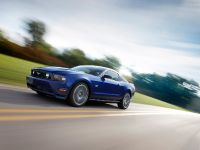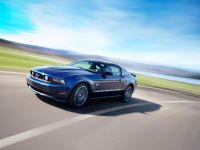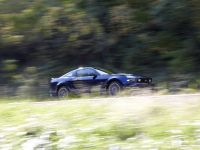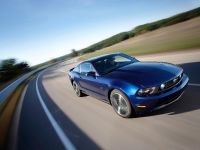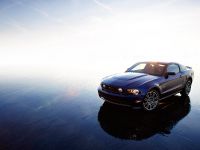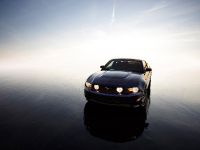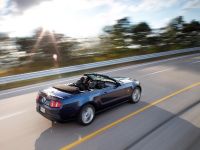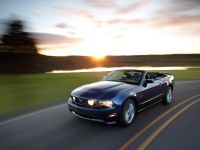Leaner, Meaner 2010 Ford Mustang Modernized
Muscle goes modern for 2010 as the Ford Mustang – America's favorite muscle car for 45 years straight – hits the streets with a new exterior design; new world-class interior featuring well-crafted materials and updated technology; and a V-8 with even more horsepower and an even throatier signature Mustang exhaust sound.
Combine those elements with the new Mustang's improved handling characteristics, more standard safety and technology features and its already-strong safety and quality performance and reputation, and it's easy to see how the muscle car known around the world delivers on the promise of fast, fun and affordable performance for a whole new era.
"More than 9 million customers have made Mustang one of the world's most beloved automotive and cultural icons," said Mark Fields, Ford's president of The Americas. "Making sure this modern legend lives up to their expectations has been a driving force for the team, which went to great lengths – gathering customer input everywhere from race tracks to Main Streets in cities throughout the U.S. – working to create the best Mustang ever."
For 2010, the team delivered. "The new Mustang marks new levels of both power and refinement," said Paul Randle, Mustang chief engineer. "We've designed and engineered this to be the next classic Mustang that everyone talks about for years and years."
In true Mustang tradition, there is a "steed for every need." At launch, customers can choose from a V-6 or V-8 with their choice of coupe, convertible or innovative glass roof, plus several new options and features delivering the opportunity for customers to personalize their cleaner, meaner-looking Mustangs.
"The best Mustangs have always been the ones that connect young America with the spirit of the times – and the 2010 does exactly that," said J Mays, Ford's group vice president of Design. "The new Mustang is close to the magnetic center of the original, fully loaded with the swagger you'd expect, but with modern refinement and attention to detail like you've never seen in a muscle car."
It starts with the more aggressive grille, punctuated with the first new Mustang emblem since the car's introduction in 1964. Both the V-6 and GT have brand-new sculptured front-end designs unique to each model. The headlamps and turn indicators, now integrated into one unit, are modern interpretations inspired by the 1970 Mustang. On the V-6, the fog lamps are located on the lower fascia, while on the GT, the fog lamps are again located in the upper grille – but are smaller than the outgoing model, similar to the original lamps of the 1967-68 models that inspired them.
"We understand Mustang's heritage and iconic status it has in the world and as a symbol of Americana," said Peter Horbury, executive director of Design, The Americas. "We wanted to create a face that is more muscular but unquestionably, unequivocally Mustang and carry that spirit through to the entire car."
The exterior sheet metal, except for the fast-back roofline, is all new for 2010. At the front, the new headlamps, lower fascias, fenders and grille are capped by a powerdome hood that adds to the muscular appearance while functionally allowing for enhanced air cooling of the engine. Mustang's washer-fluid nozzles are tucked into the cowl, while the antenna has been moved to the rear, both of which create a cleaner appearance while also reducing wind noise.
Front rear fenders feature taut, sculptured wheel flares, like a tight skin stretched over the wheels. A classic spear character line on the doors leads to a modern indication of "hip" rear fenders. "It helps give the car aggressive, forward direction, like it's ready to jump," said Doug Gaffka, Mustang chief designer.
The rear end design features aggressively angled rear corners, a sculptured decklid and prominent rear badge. A rear-view camera incorporated into the spoiler is available on some models.
A notable new tail lamp design features three LED bulbs firing sequentially from the inside for turn indication. The sequential bulbs were a distinct Mustang feature in the '60s and comeback to the 2010 for the first time since then. Locating the reverse lamps vertically creates a modern version of the Ford classic three-lens taillamp.
The best of new, heritage Cleverly combining modern technology with Mustang heritage is a signature of the 2010 model, in terms of both design and engineering.
"All of the Bullitt elements are the base foundation of the GT," said Randle, noting engine and chassis improvements. "We also applied some improvements gained from Mustang racing. We're learning constantly and always giving that to the customer on the base car."
The wheel-and-tire combinations are 1 inch bigger across the board, ranging from 17 to 19 inches, which helps improve handling and braking. The shocks have been retuned on all models as well.
"We adjusted the springs, stabilizer bars and shocks to better balance the ride, steering and handling for all models, which results in a more engaging driving experience," adds Mustang Vehicle Engineering manager Tom Barnes. "The 2010 Mustangs feel more controlled for steering and handling, yet retain a good ride balance."
The 2010 Mustang 4.6-liter V-8 benefits from innovations from the popular Bullitt model. Power has increased to 315 horsepower.
"It runs on regular gasoline, but if you put in premium it has adaptive calibration that will give you even better mid-range torque," Barnes said, adding that Easy Fuel™, Ford's innovative capless fuel system, is standard on all models.
"It's an upgrade to the most-robust, most-accessorized engine in the marketplace today," Randle added. "No one has the reliability, no one has the upgraded options. This is a fantastic engine, proven on the race track, the drag strip and on the highway."
AdvanceTrac™ Electronic Stability Control (ESC) is now standard and complements Mustang's all-speed traction control and anti-lock braking system (ABS).
"It gives a driver a little more confidence that in any type of condition the car will maintain what they want it to do," Barnes said. "The 2010 Mustang improves ride quality and maintains world-class steering and handling."
In addition to all of the design and driving dynamics improvements, the 2010 Ford Mustang is engineered to maintain its top government safety ratings. Standard safety equipment includes: dual stage front driver and passenger air bags; front seat-mounted side air bags; and, Ford's Personal Safety System.
Interior leads in design, materials, content and comfort Like the exterior, the interior design is all new with world-class materials and execution. The powerful new one-piece instrument panel design is crafted in seamless soft-touch TPO (Thermoplastic Olefin) skin fully encompassing available genuine aluminum-finish panels. Mustang's chromed-ringed gauges and dual-vane air register vents are precisely crafted and positioned.
"That's the difference between good enough and exceptional," said Gary Morales, Interior Design manager. "We wouldn't accept anything less than leadership design and world-class craftsmanship."
The instrument panel and console flow as one shape, another strong connection to Mustang heritage. The seats and arm rests have softer materials with high-quality stitching.
The new center stack design adds the latest version of Ford SYNC™, with new features 911 Assist and Vehicle Health Report. Drivers also can customize their ambient and instrument lighting through the My Color™ system, which features 125 color options.
"The centerstack is quite progressive. The electronic finish panel containing the audio and climate control buttons and knobs are integrated into the finish panel," said Kim Zielinski, Mustang Instrument Panel engineer, 2010 Mustang. "I believe the customers will really like the new look."
In addition to the improvements in technology and comfort, drivers will notice a quieter ride. "It's much more vault-like," Barnes said. "But we maintained the signature Mustang sound."
The upgraded instrument panel along with new sound deadeners added to select areas helped improve interior quietness, especially at high speeds or on rough roads. All the better to hear that famous Mustang roar.
With a completely redone exterior that echoes the classic Mustang designs of the past, an interior featuring world-class materials, numerous technology upgrades and an improved driving experience, the 2010 Mustang is poised to become the latest classic in the proud line of Ford's iconic American muscle car.
"The 2010 Mustang is drop-dead gorgeous," Randle said. "This car marks the best efforts of 45 years of passion and enthusiasm among the best designers, engineers and manufacturing experts in the business, and we can't wait for everyone to see it and start driving it."
The 2010 Mustang will be built at the Auto Alliance International Plant in Flat Rock, Mich.
2010 MUSTANG TECHNICAL SPECIFICATIONS
| BODY | |||
| Construction | Unitized welded steel body, aluminum hood | ||
| Final assembly location | Flat Rock, Mich. | ||
| POWERTRAIN AND CHASSIS | |||
| ENGINE |
V-6 |
V-8 |
|
| Type | 4.0-liter 60-degree V-6 | 4.6-liter 90-degree V-8 with cold air induction | |
| Manufacturing location | Cologne, Germany | Romeo, Mich. | |
| Configuration | Iron block and aluminum head | Aluminum block and head | |
| Intake manifold | Composite shell-welded with internal runner pack | Composite shell-welded single runner, charge motion control valves | |
| Exhaust manifold | Cast iron | Cast iron | |
| Redline | 6,100 rpm | 6,250 rpm | |
| Throttle body | 65-mm single-bore electronic | 55-mm dual-bore electronic | |
| Valvetrain | SOHC, 2 valves per cylinder | SOHC, 3 valves per cylinder, variable camshaft timing | |
| Valve diameter | Intake: 46.0 mm Exhaust: 39.0mm | Intake: 33.8 mm Exhaust: 37.5 mm | |
| Pistons | Cast aluminum | Hypereutectic aluminum | |
| Connecting rods | Forged steel | Cracked powdered metal with floating wristpins | |
| Ignition | Distributorless with coil pack | Coil-on-plug, high-thread-insert spark plugs | |
| Bore x stroke | 3.95 x 3.32/100.4 x 84.4 mm | 3.55 x 3.54/90.2 x 90.0 mm | |
| Displacement | 245 cu. in. / 4,009 cc | 281 cu. in. / 4,606 cc | |
| Compression ratio | 9.7:1 | 9.8:1 | |
| Engine control system | PCM | PCM | |
| Horsepower | 210 @ 5,300 rpm | 315 @ 6,000 rpm - estimated | |
| Horsepower per liter | 53 | 68 | |
| Torque | 240 lb.-ft. @ 3,500 rpm | 325 lb.-ft. @ 4,250 rpm - estimated | |
| Recommended fuel | 87 octane | 87 octane | |
| Fuel capacity | 16 gallons | 16 gallons | |
| Fuel injection | Electronic returnless sequential | Electronic returnless sequential | |
| Oil capacity | 5 quarts with filter | 6 quarts with filter | |
| Coolant capacity | 12.5 quarts | 14.2 quarts | |
| DRIVETRAIN | |||
| Layout |
Rear-wheel drive |
Rear-wheel drive |
|
| TRANSMISSION | |||
| Standard |
5-speed manual (Tremec T-5) |
5-speed manual (Tremec 3650) |
|
| Gear ratios | |||
| 1st |
3.75:1 |
3.38:1 |
|
| 2nd |
2.19:1 |
2.00:1 |
|
| 3rd |
1.41:1 |
1.32:1 |
|
| 4th |
1.00:1 |
1.00:1 |
|
| 5th |
0.72:1 |
0.68:1 |
|
| Final Drive |
3.31:1 |
3.55:1 |
|
| Optional | |||
| 1st |
3.22:1 |
3.22:1 |
|
| 2nd |
2.29:1 |
2.29:1 |
|
| 3rd |
1.54:1 |
1.54:1 |
|
| 4th |
1.00:1 |
1.00:1 |
|
| 5th |
0.71:1 |
0.71:1 |
|
| Final Drive |
3.31:1 |
3.31:1 |
|
| SUSPENSION | ||
| Front | Reverse-L independent MacPherson strut, 28.6-mm tubular stabilizer bar | Reverse-L independent MacPherson strut, 34-mm tubular stabilizer bar |
| Rear | 3-link solid axle with coil springs and Panhard rod and solid stabilizer bar | 3-link solid axle with coil springs, Panhard rod and 20-mm solid stabilizer bar |
| STEERING | ||
| Type | Rack and pinion with power assist | Rack and pinion with power assist |
| Ratio | 15.7:1 | 15.7:1 |
| Turning circle curb-to-curb | 33.4 ft. | 37.7 ft. |
| BRAKES | ||
| Type | Four-wheel power disc brakes with 4-sensor, 4-channel anti-lock braking system (ABS) | Four-wheel power disc brakes with 4-sensor, 4-channel anti-lock braking system (ABS) |
| Front | 293 (11.5 in) x 30 mm vented disc, twin-piston 43-mm floating aluminum calipers | 316 (12.4 in) x 30 mm vented disc, twin-piston 43-mm floating aluminum calipers |
| Rear | 300 (11.8 in) x 19 mm vented disc, single piston 43 mm floating iron calipers | 300 (11.8 in) x 19 mm vented disc, single piston 43 mm floating iron calipers |
| TIRES AND WHEELS (TYPE, SIZE) | ||
| Standard | P215/60R17 A/S 17 x 7.0-inch painted alum wheels | P235/50WR18 A/S 18 x 8.0-inch painted alum wheels |
| Optional | 17-inch machined aluminum wheel 18-inch painted aluminum wheel 18-inch polished aluminum wheel | P245/45WR18 A/S 18-inch polished aluminum wheels 19-inch machined aluminum wheels 19-inch premium painted aluminum wheels |
| DIMENSIONS (inches unless otherwise noted) | ||
|
Coupe |
Convertible |
|
| EXTERIOR | ||
| Wheelbase | 107.1 | 107.1 |
| Overall length | 188.1 | 188.1 |
| Overall width | 73.9 | 73.9 |
| Overall height | 55.6 | 56.1 |
| Track, front/rear | 62.3 / 62.9 | 62.3 / 62.9 |
| INTERIOR | ||
| Seating capacity | 4 | 4 |
| Front headroom | 38.5 | 38.8 |
| Front legroom | 42.4 | 42.4 |
| Front shoulder room | 55.3 | 55.3 |
| Front hip room | 53.4 | 53.4 |
| Rear headroom | 34.7 | 36.5 |
| Rear legroom | 29.8 | 29.8 |
| Rear shoulder room | 51.6 | 45.0 |
| Rear hip room | 46.8 | 45.2 |
| WEIGHTS AND CAPACITIES | ||
| SAE passenger volume | 83.3 cu. ft. | 81.0 cu. ft. |
| Cargo volume | 13.4 cu. ft. | 9.6 cu. ft. |
| Maximum towing capacity (properly equipped) | 1,000 lbs. | 1,000 lbs. |
| FUEL ECONOMY (city/hwy) | 5-speed Automatic | 5-speed Manual |
| 4.0-liter V-6 | TBD | TBD |
| 4.6-liter V-8 | TBD | TBD |
| BASE CURB WEIGHT (POUNDS) | ||
| Manual transmission | 3,401 estimated | 3533 estimated |
| Automatic transmission | 3,454 estimated | 3,575 estimated |
| Weight distribution (f/r) | 54/45 estimated | 54/46 estimated |
| Power-to-weight ratio | TBD | TBD |
| Manual transmission | TBD | TBD |
| Automatic transmission | TBD | TBD |
